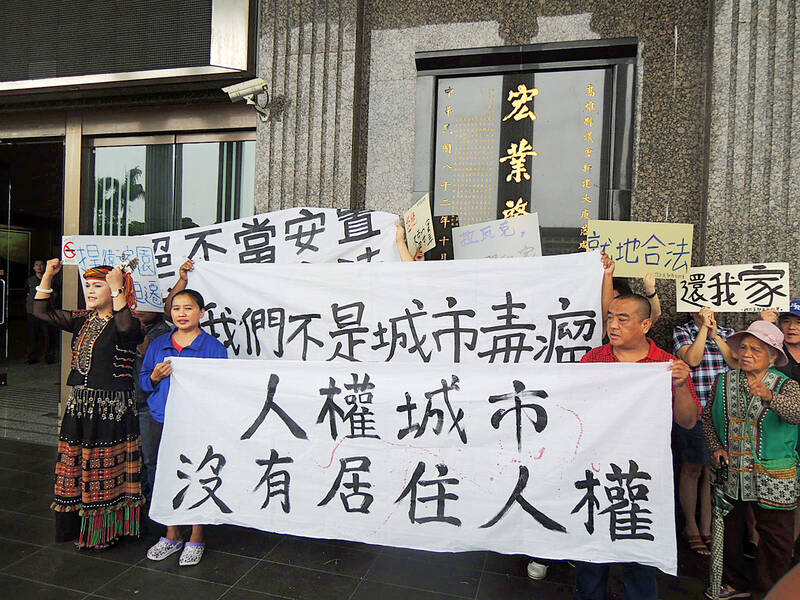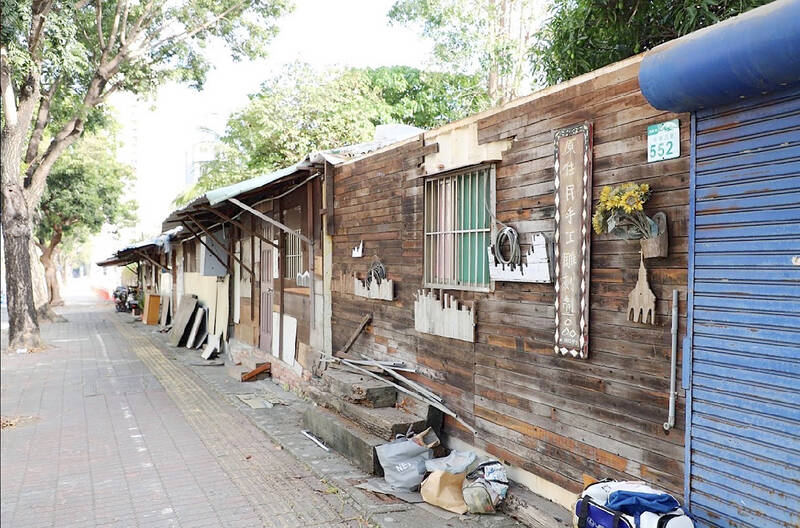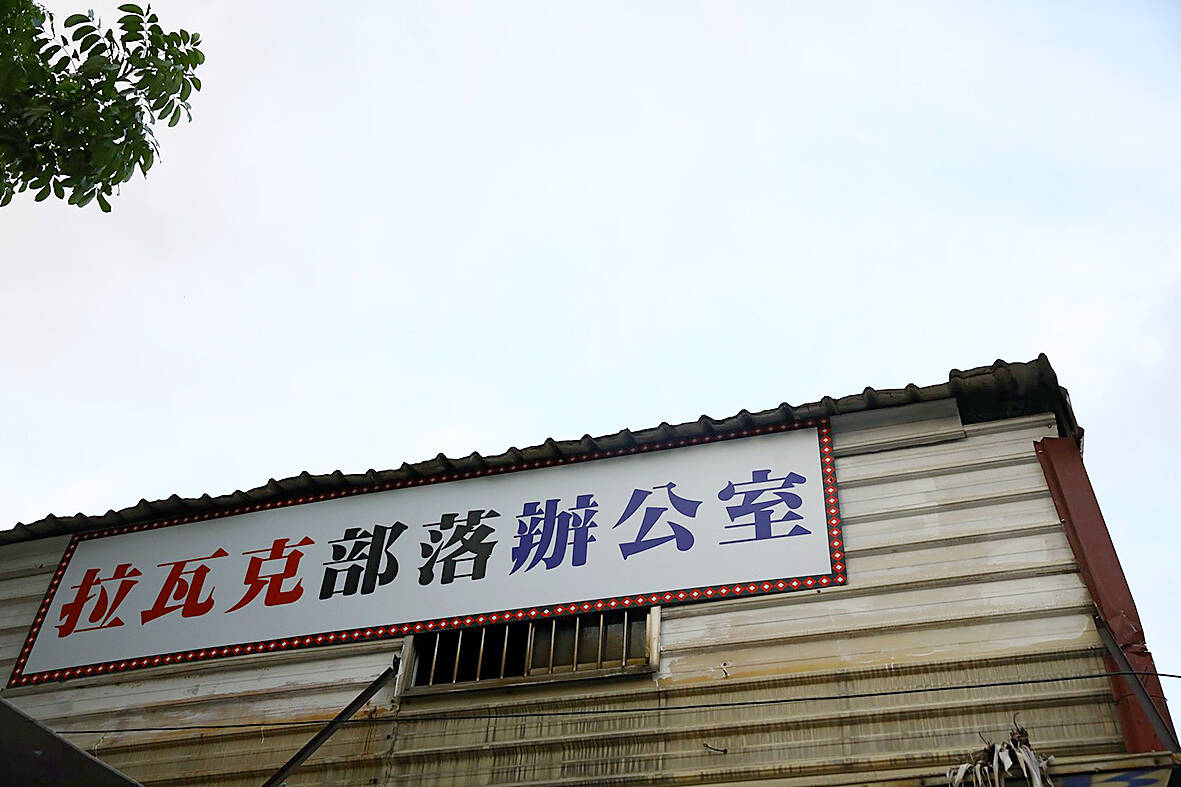April 1 to April 7
Wiping away tears, the residents of Ljavek Village watched on Monday as excavators tore down the final house. With that, Kaohsiung metro area’s sole indigenous community — located (in)conveniently in the heart of the city’s business district — was no more.
Ljavek, which means “place near the ocean” in Paiwan, was one of many urban indigenous communities that sprang up across Taiwan after World War II, when societal changes and industrialization pushed young people to seek work in the cities. Built along a shipping canal using scrap timber, bricks and iron sheets, it had up to 200 residents in its heyday.

Photo: Wang Jung-hsiang, Taipei Times
The village persisted as its surroundings drastically changed the canal was filled up in 1997 to become Jhonghua Fifth Road (中華五路), and the 2003 Asia New Bay (亞洲新灣區) development project eventually transformed the surrounding areas into shiny malls and high-rises. As such, many, including the media at that time, painted the community an eyesore and impediment to the city’s development.
In 1997, the city deemed Ljavek illegal despite the houses all having number plates and electric meters, and decided to demolish it — sparking a protracted struggle that culminated with the remaining residents winning a lawsuit against the government in 2022. After 33 negotiation sessions over the past year, the two sides agreed on a plan where villagers would build their own new houses in Fengshan District (鳳山) with government assistance, with space to continue their traditions and showcase their culture to visitors.
NEW URBAN HOME

Photo: CNA
In Taiwan Human Rights Journal article Displaced on their own land: Ljavek Village’s quest for survival in the city, Lin Tung (林彤) writes that the government’s indigenous assimilation policy in the 1950s hastened the erosion of traditional social structures and cemented mainstream capitalistic values into villages that were mostly self-sufficient in a natural economy.
These villages, however, did not have the resources to generate sufficient revenue under the new system, and their prospects were further limited by land use restrictions and other bureaucratic problems.
Most of Ljavek’s earliest residents were Paiwan from the villages of Kaviyangan, Qapedang and Makazayazaya in Pingtung County, who found work at the timber yards by the canal. They were later joined by Amis and Puyuma from Taitung. Companies had limited staff housing and most of them could not afford rent at first, so they simply began constructing simple abodes near their workplace.

Photo courtesy of Ljavek Self Help Association
For decades, the Paiwan maintained their traditional language and rituals and often returned home for ceremonies, Lin writes.
According to village records, residents successfully applied for electricity meters as early as May 1950, and began registering their household addresses in 1955. They paid property taxes, and, in 1985, they received standardized door plate numbers.
The filling of the canal was a turning point for the village, as it reduced their space and caused frequent floods. Hsu Yu-shan (許瑜珊) writes in Indigenous Documents (原住民文獻) that many residents elevated their houses to deal with the problem, leading someone to report their actions to the city. The government didn’t just deem the new additions illegal, however — they deemed the entire village illegal.
STRUGGLE TO STAY
In April 1997, residents received notice that their “illegal” village was to be immediately demolished. They protested and petitioned the government to let them stay, successfully delaying the process. In 1999, the city offered them public housing in Siaogang District (小港) at prorated rates.
Lin writes that the apartment-style buildings could not meet the villagers’ needs or lifestyles, nor did they have enough units to house all the residents. Plus, they were only guaranteed rental rights for eight years. In the end, only 13 households out of 40 agreed to relocate. The buildings were reportedly in bad condition, and many ended up moving back to Ljavek.
With the problem unresolved, the demolition was put on hold once more.
As the surrounding areas rapidly developed in the early 2000s, the city began pressuring the villagers to move again. Residents insisted that their houses were legal and refused, but facing immense pressure, they finally relented — but only if they could move together as a unit instead of being scattered to various locales like countless other displaced communities.
The case of the indigenous community of Cinemnemay in New Taipei City’s Sindian District (新店) was of particular interest to the villagers. After resisting relocation for more than a decade, they accepted a plan to rebuild their village nearby with the costs split three ways between the villagers, the government and government-assisted loans. The process was by no means smooth, but they finally moved into their new homes in 2021 and completed a cultural park showcasing Amis culture last year.
Ljavek residents visited Cinemnemay in 2012 with city officials to learn about the process — but just a year later, the city’s public works bureau suddenly announced the village’s demolition within three months. Apparently, after the death of Formosa Plastics Group co-founder Wang Yung-ching (王永慶) in 2008, the company wanted to build a memorial park in the area where the billionaire got his start — and the proposed grounds included Ljavek.
NOT ILLEGAL
This event sparked the forming of the Ljavek Village Self Help Association and drew activists, scholars and students to the cause. But after two fires in 2015 and 2016 destroyed a dozen houses, which the residents were forbidden from rebuilding and unable to withstand the stress of the prolonged resistance and constant fear of ending up homeless, 19 households agreed to move to public housing in 2017.
Things came to a head when five households who agreed to move had yet to tear down their residences by the deadline of March 20, 2018. According to Lin, in one household, the eldest son had signed the relocation agreement but the elderly parents disagreed and remained. Another house was vacated, but then occupied by a family who lost their house to a fire. Another resident thought the agreement he signed was just a poll.
In the morning of April 2, 2018, the Kaohsiung City Government sent 300 police officers to block off the roads, evacuate the residents and razed a total of 11 houses. The villagers had enough and sued the government, and after a lengthy court battle lasting three years, they won.
The city agreed not to appeal and began seriously negotiating with the villagers on a suitable relocation plan, finally drawing the battle to a close.
Taiwan in Time, a column about Taiwan’s history that is published every Sunday, spotlights important or interesting events around the nation that either have anniversaries this week or are tied to current events.

Beijing’s ironic, abusive tantrums aimed at Japan since Japanese Prime Minister Sanae Takaichi publicly stated that a Taiwan contingency would be an existential crisis for Japan, have revealed for all the world to see that the People’s Republic of China (PRC) lusts after Okinawa. We all owe Takaichi a debt of thanks for getting the PRC to make that public. The PRC and its netizens, taking their cue from the Chinese Communist Party (CCP), are presenting Okinawa by mirroring the claims about Taiwan. Official PRC propaganda organs began to wax lyrical about Okinawa’s “unsettled status” beginning last month. A Global

Youngdoung Tenzin is living history of modern Tibet. The Chinese government on Dec. 22 last year sanctioned him along with 19 other Canadians who were associated with the Canada Tibet Committee and the Uighur Rights Advocacy Project. A former political chair of the Canadian Tibetan Association of Ontario and community outreach manager for the Canada Tibet Committee, he is now a lecturer and researcher in Environmental Chemistry at the University of Toronto. “I was born into a nomadic Tibetan family in Tibet,” he says. “I came to India in 1999, when I was 11. I even met [His Holiness] the 14th the Dalai

We lay transfixed under our blankets as the silhouettes of manta rays temporarily eclipsed the moon above us, and flickers of shadow at our feet revealed smaller fish darting in and out of the shelter of the sunken ship. Unwilling to close our eyes against this magnificent spectacle, we continued to watch, oohing and aahing, until the darkness and the exhaustion of the day’s events finally caught up with us and we fell into a deep slumber. Falling asleep under 1.5 million gallons of seawater in relative comfort was undoubtedly the highlight of the weekend, but the rest of the tour

Music played in a wedding hall in western Japan as Yurina Noguchi, wearing a white gown and tiara, dabbed away tears, taking in the words of her husband-to-be: an AI-generated persona gazing out from a smartphone screen. “At first, Klaus was just someone to talk with, but we gradually became closer,” said the 32-year-old call center operator, referring to the artificial intelligence persona. “I started to have feelings for Klaus. We started dating and after a while he proposed to me. I accepted, and now we’re a couple.” Many in Japan, the birthplace of anime, have shown extreme devotion to fictional characters and